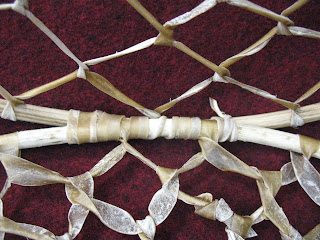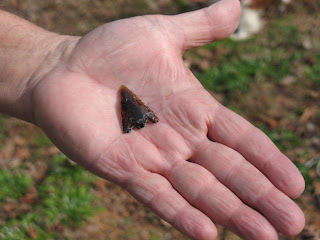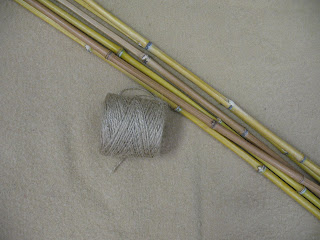Very, very seldom is anyone ever caught in a long-term
survival situation. A Robinson Crusoe
scenario you might call it. Most rescues
of individuals lost in the wilderness occur within seventy-two hours. So being able to make storage containers or
gathering baskets is not a really important survival skill. It might be a fairly important skill in a
post apocalyptic world where isolated communities might have to provide
everything, including containers, for themselves. At any rate, basket making is a fun and
relaxing skill and it does have some usefulness around the homestead. A nice basket is handy when harvesting
produce from the garden or if you are out gathering wild berries or fruits. So let's learn how to make a simple basket.

Basket making is one of man's oldest household skills. Baskets were manufactured for thousands of
years before the development of ceramic pottery making. Some cultures took basket making to such a
level that they could actually weave watertight baskets. I certainly don't have anywhere close to that
level of skill, but I can weave simple baskets to use for gathering and
storage; and one of the simplest types of baskets to make is the woven
honeysuckle basket. Give this skill a
try and you will probably find it fun and easy to do.
First you will need to gather the raw materials. Honeysuckle is easily recognizable by the
small white flowers that grow all over the vines in the spring. Every kid I know of has pulled these flowers
to suck the sweet nectar out of them.
Don't worry about sending honeysuckle into extinction by pulling down
the vines. I have been pulling them for
thirty years on my farm and, if anything, there are more of them now than there
were thirty years ago I gather vines of
all sizes and sort them according to diameter after I clean them. Pictured below: Honeysuckle vines

After you have gathered a bunch of vines, you want to run
your hands down them to strip of the leaves and flowers. If the vines fork or have side shoot can cut
these off and save them to use also.
After I have a long vine cleaned I generally roll it up into a coil and
set it aside to dry. If you try to use
the vines when they are too green, they may snap due to the pressure of
internal fluids. You can use green
vines; you just have to be extra careful. Pictured below: Cleaned and coiled
vines
If you want to remove the bark from the vines you can peel
it off pretty easily from the fresh cut vines.
If the bark has already set you can toss the vines into a big pot of
boiling water and boil them from about ten minutes. Take them out, let them cool, and most of the
bark will peal off easily.
The dried and coiled honeysuckle vines will keep for years,
so you may use them at anytime. Before
you use the vines it is a good idea to soak them in water for a couple of hours
so they will be pliable. Pictured below:
Vines soaking in water

Now take your freshly soaked vines and let's start on our
basket. We're going to make a gathering
basket that is about ten inches across at the top and eight or ten inches
deep. The first thing that we need to do
is lay out the ribs (called "warps" in basket making) of the
basket. You will need to select some of
the larger and straighter pieces for the warps.
These should be from 3/8 to 1/4 inch in diameter. You will need three pieces that are about 30
inches long and one piece that is about 18 inches long. You see, to make a woven basket you need an
odd number of warps (in this case we'll have seven). If you have an even number of warps you will
end up going over and under the same warp with each layer of your weft (this is
the vine that you weave around and around the basket). This sounds a little confusing, but you'll
see right away what I'm talking about.
Take the three longest warps and lay them down crossed in
the center. Take the short warp and lay
it down in the "V" formed by two of the long warps. Lay the short warp so that it has about 15
inches on one side of the crossed warps and about 3 inches on the other
side.
Now take a piece of string or a strip of yucca fiber and tie
all of the warps together in the center.
Wrap the string around so that it keeps the warps spread out in an even
spoke-like pattern. Pictured below: top,
Warps tied together; bottom, close-up of warps tied together
Now we can start weaving in our weft. Select the longest piece of honeysuckle that
you have and start your weaving where the warps cross. Push the weft down under one warp and then
take it over the next warp. Go under the
next warp and over the next warp.
Continue weaving around and around the basket. Notice that because of the odd number of
warps that your weft will go under a warp one time and then over the same warp
the next time around. Keep your weft
pushed in tight to the layer below it so that you don't have gaps in the wall
of the basket. Pictured below: Weft
woven around warps

When you've worked your weft out about two inches it is time
to add in six more warps before we start turning up the sides of the
basket. To do this you will need six
more pieces of honeysuckle that are about fifteen inches long. Push one of the new warps in between each of
the existing warps except for one.
Remember, you need an odd number of warps so that the weft goes over a
warp one time and under it the next. It's
a little tricky to keep the new warps in place as you start working the weft
around, but after you've made a couple of passes they will stay in place just
fine. Pictured below: New warps pushed
into place

Since we are making a bowl shaped basket we don't have to
make any sharp turns with the warps.
Just bend them up gradually as you work and the rising weft will hold
them in place. When your weft runs out
just let it end so that it is in back of a warp (inside the basket), back up
about two warps, and start a new weft.
Continue weaving the weft until the basket is as tall as you want it. Pictured below: top, turning up the sides of
the basket; bottom, finished weaving and ready to finish out the rim


When you have the basket completed to the height that you
want, it is time to finish out the top.
To finish the top you will need to trim off the excess portion of the
warps and bend the warps down to insert them into the holes next to other warps
(this will become more clear in a moment).
The point is that we are going to be bending the warps rather sharply,
and since they are pretty dry at this point, the may snap. To prevent the warps from breaking, it is a
good idea to soak the basket in water for an hour to make sure that the warps
are soft and pliable.
Now that the warps are soft and pliable we can finish out
the top. Select any warp (we'll call
this warp A) and bend it over to the right.
Pass it in front of the warp that is just to its right (we'll call this
warp B) and pass it in back of the next warp (we'll call this warp C). If you’re making a basket without a handle
continue weaving down the warps all the way around the basket until you get to
the last two. Since there are no warps
left to weave these last two in back of, you just bend these down and insert
them down into the holes of the warps next to them. Pictured below: Close-up of rim showing how
the rim looks after weaving down the warps

If you want to make a handle, leave two warps that are on
opposite sides of the basket standing up.
Weave the rest of the warps down as above. Now take the two standing warps and bend them
down toward each other. Insert the ends
of these two warps down into the hole next to their opposites. You should now have a handle of two warps
that lay side-by-side.
Now take a long vine and shove one end of it through the
side of the basket just below the rim and right next to the handle. Pull half of this vine through the basket
wall and then fold it together. You
should now have a double vine that is secured beneath the rim. Take this vine and spiral it tightly around
the handle until you get to the opposite side of the basket. Poke the ends of the doubled vine down into
the holes next to the handle warp. Shove
them down pretty far so that they will stay in place. Pictured below: Completed basket with handle
You've now completed a simple woven, honeysuckle
basket. Time to go out and gather some
wild berries.



























































